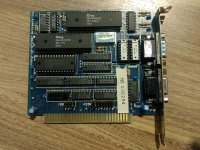That is an idea but at this moment a few levels above my paygrade, if you know what I mean.
But it is in the line with an idea I have: I found an old card with eight COM ports and the idea is to use that as an intelligent switch. You start up the software on the PC and it connects to this switch. The switch tells you what other connections are available, you make you pick and start exchanging the software.
A step further would to expand this to a real network where one PC can address more PCs at the time.
The "intelligent" part could be opening a can of worms. There's a concept of session behind that workflow. In a point of time, your serial connection is handled on the other side by hub software, in another point of time, it's routed to physical peer. What denotes the session lifecycle on the hub side?
Practically speaking, serial networked computers cannot be apart. If you can't see the use case where you can't walk to another computer in the 'network', then 'intelligent switch' is not necessary, use just a dumb router instead. Who is connected to who is configured on the 'hub' PC.
If you wanted to really up the design I'd use second serial connection to the hub PC for switch menu 'terminal', so you can switch connection from client. Two COM ports, data and management.
Because yeah everything else that even smells a bit of network will have to have all the layers that perform what OSI layers do. So why even bother when you can encapsulate IP in serial.
We are on a similar train of thought I'd just rather use a modern computer with serial routing software using USB to serial cables than do the same thing with DOS and multiport cards.
An instant feature you may get is internet transport. There won't be any one click solutions for it but it is possible and programmatically easy to transport serial streams from the modern computer handling them to another over the internet. So you could copy files around in Norton Commander's serial link to a remote computer for instance.


